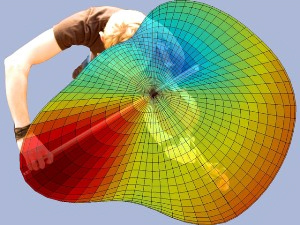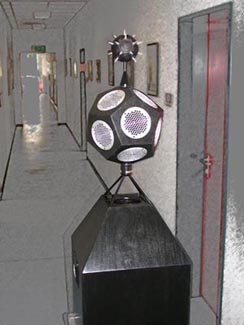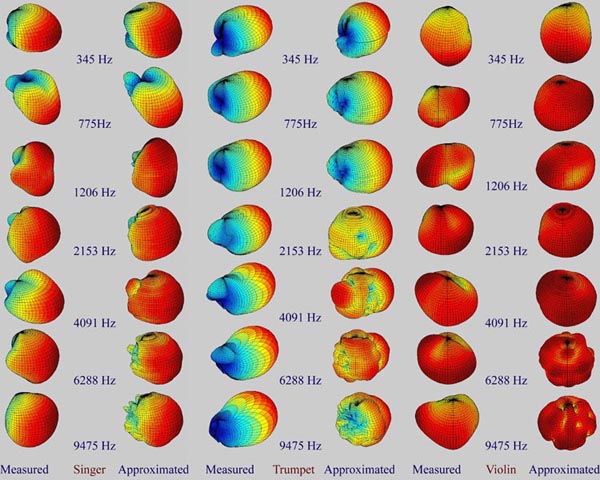Gottfried K. Behler - gkb@akustik.rwth-aachen.de
Institute of Technical Acoustics, RWTH Aachen University, Templergraben 55, D-52056 Aachen, Germany
Popular version of paper 4aAA7
Presented Friday morning, December 1, 2006
4th ASA/ASJ Joint Meeting, Honolulu, HI
Introduction
Rooms, especially concert halls, have a decisive influence on the sound of voices and instruments. The reason is the reflection of sound waves at the rooms boundaries. In the open sound field, such as a football field, such reflections do not exist and the transmission of sound
occurs only via the so-called direct way. The energy of the sound waves, supplied by reflections and reverberations, also increases the perceived sound volume and is therefore very useful for a concert hall, where people listen to a performance.

Figure 1: Schematic energetic room impulse response.
The process of reflections at a listeners seat is modeled in Figure 1. On the one hand, it is recognizable that individual reflections reach the listener with a time delay and increasingly weaker as time advances. This is because sound spreads at only a finite speed and the reflection areas are located at different distances in many different directions (which is not shown in this two-dimensional plot). On the other hand, the density of the reflections increases strongly with time, because additional reflections are generated from every reflected sound wave. This process, which the room acoustician refers to as the room impulse response, depends on the geometry, shape, size, and surface material of the room. The "quality" of this impulse response is of great importance for concert buildings, and there are lots of criteria which allow a technical-scientific evaluation of the room impulse response. The room impulse response is measured by placing an omni-directional sound source on the stage and recording the sound generated by the source using microphones at places in the audience.
For a comparison of different concert halls, a consideration of the room acoustical parameters just mentioned and the reverberation time, clarity, degree of lateral sound, and sound intensity measure, are performed as usual. Apart from the reverberation time, which will presumably still serve as a discernable criterion for normal concert goers, all the other parameters are only comprehensible and interpretable for evaluation purposes by specialists, namely room acousticians. However, what is needed is a direct comparison of acoustics through listening in a concert hall. It is unfortunate that it is hardly possible to be in the Boston Symphony Hall and in the Konzertgebouw Amsterdam at the same time and to have the same musicians performing the same music with the same quality. It is due to this problem that ambitious plans for an objectified subjective comparison of concert halls has failed in the past.
The comparison becomes substantially simpler when only the impulse responses of the rooms are recorded and then processed ("convoluted" in technical terms) in a laboratory with suitable test signals (e.g. sounds of instruments, short presentations of orchestras, etc.) recorded without any reverberation. The obtained signals will be replayed by headphones. If the measurement of the impulse response is done with a stereophonic dummy-head microphone, then the listener will virtually be able to put him or herself in the very position in the concert hall where the impulse response was recorded. Switching between different positions in a hall or even between completely different halls is then easily possible with a keystroke.
Method and results
Since musical instruments do not radiate their sound omni-directionally, it is not possible to use omni-directional room impulse response measurements (which are required to calculate the parameters) for listening tests. This becomes
evident when the hall is arranged in such a way that the listeners are grouped around the stage, so that listeners can also sit behind the orchestra or the grand piano. The directivity of a violin, as shown in Figure 2, demonstrates that the people sitting behind the musician are at a
disadvantage. Since this affects in the first place only the direct sound, it is even more important to consider the sound being reflected via the walls with the correct intensity and tone color in the result, in order to be able to represent correctly the actual listening situation in the room at a particular place.

Figure 2: Sound radiation of a violin player.
The loudspeakers used for measurement purposes are mostly dodecahedron loudspeakers, where 12 identical loudspeaker systems are installed in a housing being made out of 12 equilateral pentagons. To cover the wide frequency range and to maintain a smooth spherical radiation pattern a single dodecahedron loudspeaker is not sufficient. A modern three-way measurement loudspeaker that copes with most requirements is shown in Figure 3. To change the directivity to match with the directivity of a particular instrument is not a straight forward task. One difficult but plausible solution is to design loudspeaker cabinets that inherently form the directional pattern.

Figure 3: Three-way measuring loudspeaker with dodecahedron arrangement of speakers for omni-directional sound radiation.
In the case of a singer, this becomes relatively simple, because the sound is radiated from the opening of his mouth, so that a puppet with a loudspeaker in its mouth would allow accurate measurements of this property (see Figure 4). In addition to the considerable expenditure that such a development would cause, different loudspeakers would also be required for different instruments. This would also entail a considerable expenditure in connection with the measurements.

Figure 4: Dummy-head loudspeaker with directivity of a human singer.
A far better and cheaper alternative is the use of a single loudspeaker, the directivity of which may be electronically adjusted. An arrangement with an adequate number of transducers aligned at equal intervals is best suited. For this reason, the already existing loudspeaker, shown in Figure 3, is modified in such a way that each of the 12 loudspeakers may be connected separately. It is possible to adjust the amplitude and the phase of each loudspeaker independently and freely via a filter.
Using optimization calculations, the individual filters can now be generated in such a way that target directivity characteristics are assumed to be coming, for example, from the measurement of a real instrument. Three examples are represented in the following figure for a singer, a trumpet, and a violin. Even though these are only preliminary results of a simulation, based on the measured directivity characteristics, the potential of this procedure becomes evident. The filters can be switched in the electronic system without any loss of time, so during measurements, one can switch between the directivity characteristics of a spherical source according to standard and those directivity characteristics which have been optimized with respect to any instrument or a group of musicians.

Figure 5: Comparison of the measured directivity and the approximated directivity from the three-way dodecahedron source from Figure 3 for a human singer, a trumpet and a violin (from left to right).
Summary and outlook
Measurements of room impulse responses are common tasks in room acoustics. However, the wish to compare different halls in listening tests requires using binaural recording techniques in combination with aligned source directivity. The proposed method can be used to cover a wide variety of different source directivities and to make the expense for such measurements feasible.
Single instruments are easily matched with this technique, and a full orchestra is a compilation of several instruments, and therefore it would be possible to superimpose several measurements to cover a chamber music ensemble.
The occasionally questionable method of subjective listening tests could be improved significantly by applying this method.